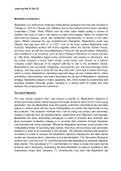Samenvatting
Summary Managerial Statistics Keller Chapter 1-10 formula and concepts overview
- Instelling
- Erasmus Universiteit Rotterdam (EUR)
Concepts and formula overview statistics (Managerial statistics 9th edition) Year 1 IBA bachelor // Pre-master recap Chapter 1 - 10
[Meer zien]














